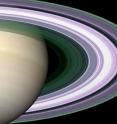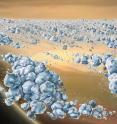Scientists solve planetary ring riddle
Study suggests planetary rings have a universal particle distribution Study solves 'amazing' mathematical inverse cubes law of particle size distribution In a breakthrough study, an international team of scientists, including Professor Nikolai Brilliantov from the University of Leicester, has solved an age-old scientific riddle by discovering that planetary rings, such as those orbiting Saturn, have a universally similar particle distribution.
The study, which is published in the academic journal Proceedings of the National Academy of Sciences (PNAS), also suggests that Saturn's rings are essentially in a steady state that does not depend on their history.
Professor Brilliantov from the University of Leicester's Department of Mathematics explained: "Saturn's rings are relatively well studied and it is known that they consist of ice particles ranging in size from centimetres to about ten metres. With a high probability these particles are remains of some catastrophic event in a far past, and it is not surprising that there exists debris of all sizes, varying from very small to very large ones.
"What is surprising is that the relative abundance of particles of different sizes follows, with a high accuracy, a beautiful mathematical law 'of inverse cubes'. That is, the abundance of 2 metre-size particles is 8 times smaller than the abundance of 1 metre-size particles, the abundance of 3 metre-size particles is 27 times smaller and so on. This holds true up to the size of about 10 metres, then follows an abrupt drop in the abundance of particles. The reason for this drastic drop, as well as the nature of the amazing inverse cubes law, has remained a riddle until now.
"We have finally resolved the riddle of particle size distribution. In particular, our study shows that the observed distribution is not peculiar for Saturn's rings, but has a universal character. In other words, it is generic for all planetary rings which have particles to have a similar nature."
Most of the planets in the Solar System have smaller bodies, or satellites, that orbit a planet. Some of them, such as Saturn, Jupiter, Uranus and Neptune, additionally possess planetary rings - a collection of still smaller bodies of different sizes that also orbit a planet. It is likely that planetary rings also exist beyond the Solar System.
Large asteroids, such as Chariklo and Chiron, only a few hundred kilometres in diameter, are also surrounded by rings.
Professor Brilliantov added: "The rather general mathematical model elaborated in the study with the focus on Saturn's rings may be successfully applied to other systems, where particles merge, colliding with slow velocities and break into small pieces colliding with large impact speeds.
"Such systems exist in nature and industry and will exhibit a beautiful law of inverse cubes and drop in large particle abundance in their particle size distribution."
Source: University of Leicester
Other sources
- Study: All planetary rings governed by particle distribution principlefrom UPIWed, 5 Aug 2015, 20:30:17 UTC
- Scientists solve planetary ring riddlefrom Science BlogWed, 5 Aug 2015, 16:20:10 UTC
- Scientists solve planetary ring riddle: Universal particle distribution of Saturn's ringsfrom Science DailyWed, 5 Aug 2015, 15:30:18 UTC
- Scientists solve planetary ring riddlefrom PhysorgWed, 5 Aug 2015, 13:30:11 UTC

